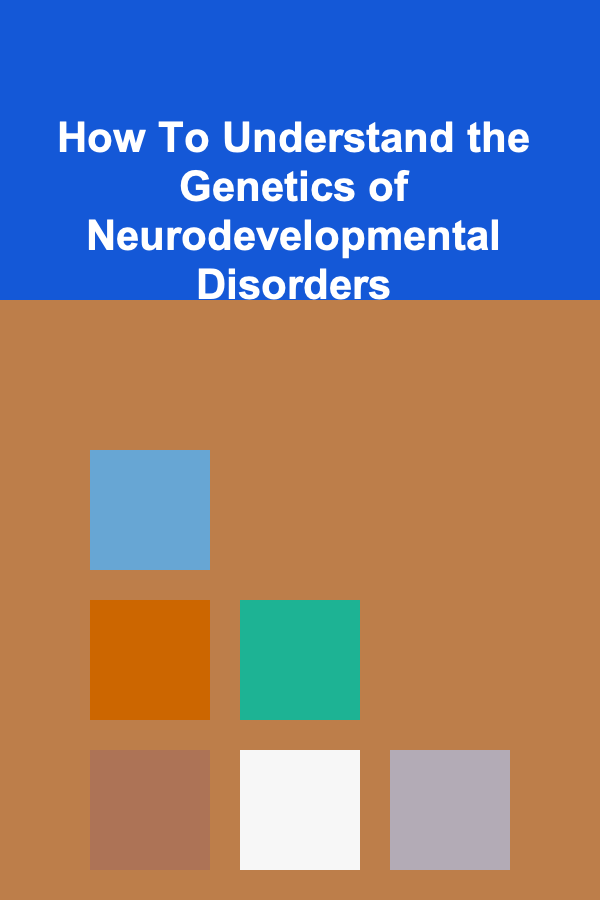
How To Understand the Genetics of Neurodevelopmental Disorders
ebook include PDF & Audio bundle (Micro Guide)
$12.99$10.99
Limited Time Offer! Order within the next:

Neurodevelopmental disorders are a diverse group of conditions that manifest early in life and affect the development of the nervous system. These disorders can lead to a range of impairments in areas such as cognition, motor skills, language, and social behavior. Understanding the genetics of these disorders is crucial for developing better diagnostic tools, treatments, and potentially preventative strategies.
This article aims to provide an in-depth exploration of the genetics behind neurodevelopmental disorders. It will cover the basics of genetics, the role of genes in neurodevelopment, the connection between specific genetic mutations and disorders, and the implications of genetic research for diagnosis and treatment.
The Basics of Genetics in Neurodevelopment
What Are Neurodevelopmental Disorders?
Neurodevelopmental disorders are a broad category of conditions that arise during the early stages of brain development. These disorders can involve a variety of symptoms, such as developmental delay, intellectual disabilities, autism spectrum disorders (ASD), attention-deficit hyperactivity disorder (ADHD), learning disabilities, and more.
These disorders are thought to result from disruptions in the complex process of neurodevelopment, which includes the formation and maturation of the brain, as well as the connections between neurons.
The Role of Genes in Brain Development
At the core of neurodevelopment lies the intricate process by which the brain develops and forms its many neural networks. During development, the brain undergoes rapid changes in its structure and function, guided by genetic instructions. Genes are the blueprints that dictate how the brain is wired, and alterations in these genes can lead to neurodevelopmental disorders.
Genetics plays a key role in how neurons are formed, how they communicate with each other, and how the brain adapts to its environment. In fact, numerous genes are involved in the development of the central nervous system (CNS), and their functions can be disrupted by mutations, deletions, or duplications in the DNA sequence.
Genetic Mechanisms Behind Neurodevelopmental Disorders
Gene Mutations
Mutations in specific genes are often implicated in neurodevelopmental disorders. These mutations can be inherited from one or both parents, or they can arise spontaneously during development (de novo mutations).
There are different types of mutations that can occur:
- Point mutations: A single nucleotide in the DNA sequence is changed, which can disrupt the function of the corresponding protein.
- Insertions and deletions: Extra nucleotides may be inserted, or a segment of DNA may be deleted, leading to changes in the protein's structure and function.
- Copy number variations (CNVs): These are large segments of DNA that may be duplicated or deleted, affecting the number of copies of a gene and disrupting normal development.
- Chromosomal abnormalities: In some cases, entire chromosomes may be gained or lost, leading to significant changes in the genetic code.
These mutations may affect a wide range of genes, but many of them are involved in critical processes like cell signaling, neural development, synaptic function, and neuronal survival. Some of the most well-known genes associated with neurodevelopmental disorders include MECP2 , FMR1 , CNTNAP2 , and SHANK3.
De Novo Mutations in Neurodevelopmental Disorders
De novo mutations are those that arise spontaneously in the individual, without being inherited from either parent. These mutations are especially common in neurodevelopmental disorders, particularly in conditions like autism, intellectual disability, and schizophrenia.
The phenomenon of de novo mutations is crucial because it can occur in genes that are otherwise healthy in the parents, yet lead to significant changes in the individual's development. Such mutations are often rare, but they can have profound effects on the individual's cognitive and behavioral traits.
One example of a neurodevelopmental disorder associated with de novo mutations is autism spectrum disorder (ASD). Studies have shown that many individuals with ASD have mutations in genes that are involved in synaptic function, neural communication, and brain wiring. These mutations may disrupt the normal connections between neurons, leading to the characteristic symptoms of autism, including social communication difficulties, restricted interests, and repetitive behaviors.
Genetic Disorders Linked to Neurodevelopmental Diseases
Several neurodevelopmental disorders have well-established genetic links. Some of these are primarily caused by mutations in single genes, while others are influenced by a combination of genetic factors.
Autism Spectrum Disorder (ASD)
Autism spectrum disorder (ASD) is one of the most well-known neurodevelopmental disorders, characterized by difficulties in social communication and restricted, repetitive behaviors. It is estimated that genetics contribute to approximately 80% of the risk of developing ASD.
There are many genetic mutations associated with autism, including variations in genes such as SHANK3 , CNTNAP2 , FMR1 , and NRXN1 . These genes are involved in synaptic function, neuronal communication, and brain plasticity. For example, mutations in SHANK3 are implicated in Phelan-McDermid syndrome, a rare condition that often includes autism as one of its symptoms.
Additionally, copy number variations (CNVs) in regions like 16p11.2 have been strongly linked to autism. These CNVs involve duplications or deletions of genetic material, disrupting the normal function of critical genes involved in brain development.
Fragile X Syndrome
Fragile X syndrome is a genetic condition that causes intellectual disability, particularly in males. It is the most common inherited form of intellectual disability. The cause of fragile X syndrome is a mutation in the FMR1 gene, located on the X chromosome.
This mutation leads to the loss of fragile X mental retardation protein (FMRP), which plays a crucial role in synaptic plasticity and the development of neural connections. The absence of FMRP disrupts normal brain function, leading to the intellectual and developmental impairments seen in individuals with fragile X syndrome.
Rett Syndrome
Rett syndrome is a neurodevelopmental disorder that primarily affects females. It is caused by mutations in the MECP2 gene, which is responsible for regulating the expression of other genes involved in brain development.
Initially, children with Rett syndrome develop normally, but around 6 to 18 months of age, they begin to lose motor and cognitive skills, including speech, coordination, and hand movements. Mutations in the MECP2 gene disrupt the normal functioning of neurons, particularly in the brain regions responsible for motor control and communication.
Intellectual Disabilities and Other Syndromes
Intellectual disabilities (ID) are a group of disorders characterized by limitations in intellectual functioning and adaptive behavior. Several genetic mutations are known to cause ID, including those associated with Down syndrome , Williams syndrome , Angelman syndrome , and Prader-Willi syndrome. These disorders are often linked to chromosomal abnormalities, such as trisomy 21 in Down syndrome or deletions in the 15q11-13 region in Angelman and Prader-Willi syndromes.
How Genetics Research is Advancing Our Understanding of Neurodevelopmental Disorders
Whole Genome Sequencing (WGS)
Whole genome sequencing (WGS) has revolutionized genetic research by enabling scientists to examine the entire genetic code of an individual. This technology allows researchers to identify previously unknown genetic mutations associated with neurodevelopmental disorders.
For example, WGS has led to the discovery of many new genes linked to autism and other disorders. By comparing the genomes of affected individuals to those of healthy individuals, scientists can pinpoint specific mutations that contribute to the disease.
Gene Editing and CRISPR
The development of gene-editing technologies like CRISPR-Cas9 has opened up new possibilities for studying and potentially treating genetic neurodevelopmental disorders. CRISPR allows researchers to precisely edit genes within living organisms, which could one day enable them to correct genetic mutations in individuals with neurodevelopmental disorders.
In animal models, CRISPR has been used to correct mutations in genes associated with autism and intellectual disabilities. While the technology is still in its early stages, it holds great promise for developing targeted therapies in the future.
Epigenetics and Environmental Interactions
Epigenetics refers to changes in gene expression that do not involve changes in the DNA sequence itself. Environmental factors, such as diet, stress, and toxins, can influence the way genes are expressed, potentially contributing to the development of neurodevelopmental disorders.
Research in epigenetics has shown that environmental factors can have a significant impact on brain development, especially during critical periods of neurodevelopment. This research could lead to new therapeutic strategies aimed at modifying gene expression to prevent or treat neurodevelopmental disorders.
The Future of Genetics and Neurodevelopmental Disorders
The field of neurogenetics is rapidly advancing, and researchers are continually uncovering new insights into the genetic underpinnings of neurodevelopmental disorders. However, much remains to be understood about the complex interactions between genes, the environment, and brain development.
Future research will likely focus on the following areas:
- Personalized medicine: By understanding the genetic basis of neurodevelopmental disorders, doctors may be able to tailor treatments to the specific genetic makeup of an individual.
- Gene therapies: As gene-editing techniques improve, it may become possible to correct genetic mutations that cause neurodevelopmental disorders.
- Early detection and prevention: Genetic screening and prenatal testing could help identify individuals at risk for neurodevelopmental disorders, allowing for earlier intervention.
By continuing to explore the genetic mechanisms behind neurodevelopmental disorders, we can better understand these conditions and develop more effective treatments for those affected.
Conclusion
The genetics of neurodevelopmental disorders is a rapidly evolving field that holds tremendous promise for understanding the root causes of these conditions and developing better diagnostic tools and treatments. While we have made significant strides in uncovering the genetic mutations associated with neurodevelopmental disorders, much remains to be learned about how these mutations disrupt brain development and function.
As technology advances and our understanding of genetics deepens, we can look forward to more personalized, targeted therapies that offer hope for individuals and families affected by these conditions. The future of neurogenetics holds exciting potential, with the promise of more effective treatments, earlier interventions, and a deeper understanding of the complexities of the human brain.

Beginner Guide: The Art of Public Speaking
Read More
How to Clean Your Fireplace and Maintain It Properly
Read More
How to Prepare Your Rental Property for New Tenants
Read More
How to Use DIY Techniques for Effective Soundproofing
Read More
How to Invest in Carbon Capture Technologies
Read More
How to Build a Remote Controlled Robot Car with Arduino
Read MoreOther Products

Beginner Guide: The Art of Public Speaking
Read More
How to Clean Your Fireplace and Maintain It Properly
Read More
How to Prepare Your Rental Property for New Tenants
Read More
How to Use DIY Techniques for Effective Soundproofing
Read More
How to Invest in Carbon Capture Technologies
Read More